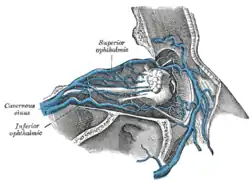Superior ophthalmic vein
The superior ophthalmic vein is a vein of the orbit around the eye. It begins from the angular vein and the supraorbital vein, and passes through the superior orbital fissure to drain into the cavernous sinus. It drains the ethmoidal veins, the lacrimal vein, the central retinal vein, some vorticose veins, and veins from two rectus muscles. It can be a path for the spread of infection from the danger triangle of the face to the cavernous sinus and the pterygoid plexus. It may also be affected by an arteriovenous fistula of the cavernous sinus, treated with embolization.
| Superior ophthalmic vein | |
|---|---|
 Veins of orbit. (Superior ophthalmic labeled at top.) | |
 The sinuses at the base of the skull. (Superior ophthalmic vein labeled at upper right.) | |
| Details | |
| Source | vorticose veins |
| Drains to | cavernous sinus |
| Artery | ophthalmic artery |
| Identifiers | |
| Latin | vena ophthalmica superior |
| TA98 | A12.3.06.102 |
| TA2 | 4887 |
| FMA | 51246 |
| Anatomical terminology | |
Structure
The superior ophthalmic vein begins from the angular vein (through the orbital septum) and the supraorbital vein (through the supraorbital notch).[1] The superior ophthalmic vein does not pursue the exact same course as the ophthalmic artery (which instead passes through the optic canal). Instead, it forms a short single trunk. It passes below the superior rectus muscle, and between the two heads of the lateral rectus muscle. It must cross the optic nerve (CN II) from lateral to medial.[1] It passes through the upper part of the superior orbital fissure.[1] It drains into the cavernous sinus.[1][2] It is usually between 2 mm and 10 mm in diameter.[3]
The superior ophthalmic vein is larger than the inferior ophthalmic vein.[1] It receives tributaries corresponding to the branches of that vessel.[1] The anterior ethmoidal vein and the posterior ethmoidal vein drain into the superior ophthalmic vein.[1][4] The lacrimal vein, the central retinal vein, and some vorticose veins also drain into the superior ophthalmic vein.[1] Veins from the superior rectus muscle and the medial rectus muscle also join it.[1]
Function
The superior ophthalmic vein drains the orbit. These include the superior rectus muscle, the medial rectus muscle, the lacrimal gland, and the retina.[1] The inferior ophthalmic vein also helps to drain the orbit.[1]
Clinical significance
Cavernous sinus thrombosis
The medial angle of the eye, nose and lips (known as the danger triangle of the face) usually drain through the facial vein, via the superior ophthalmic vein through the cavernous sinus. An infection of the face may spread to the cavernous sinus through the superior ophthalmic vein.[3] This can cause cavernous sinus thrombosis.[3] This can lead to damage of the nerves running through the cavernous sinus.
Arteriovenous fistula
When arteriovenous fistula affects the cavernous sinus, blood flow may occur backwards in the superior ophthalmic vein.[5] This can cause exophthalmos.[5] This may be treated by embolising the superior ophthalmic vein.[6]
See also
References
![]() This article incorporates text in the public domain from page 659 of the 20th edition of Gray's Anatomy (1918)
This article incorporates text in the public domain from page 659 of the 20th edition of Gray's Anatomy (1918)
- Remington, Lee Ann (2012). "11 - Orbital Blood Supply". Clinical Anatomy and Physiology of the Visual System (3rd ed.). Butterworth-Heinemann. pp. 202–217. doi:10.1016/B978-1-4377-1926-0.10011-6. ISBN 978-1-4377-1926-0.
- Moini, Jahangir; Piran, Pirouz (2020). "5 - Blood supply of the CNS". Functional and Clinical Neuroanatomy - A Guide for Health Care Professionals. Academic Press. pp. 131–176. doi:10.1016/B978-0-12-817424-1.00005-7. ISBN 978-0-12-817424-1.
- Semmer, A. E.; McLoon, L. K.; Lee, M. S. (2010). "Orbital Vascular Anatomy". Encyclopedia of the Eye. Academic Press. pp. 241–251. doi:10.1016/B978-0-12-374203-2.00284-0. ISBN 978-0-12-374203-2.
- "Ethmoidal veins" at Dorland's Medical Dictionary
- Fielding, John A. (2011). "47 - The eye and orbit". Clinical Ultrasound. Vol. 2 (3rd ed.). Churchill Livingstone. pp. 938–964. doi:10.1016/B978-0-7020-3131-1.00047-X. ISBN 978-0-7020-3131-1.
- Ahmed, A.; Albuquerque, F. C. (2014). Encyclopedia of the Neurological Sciences - Reference Module in Neuroscience and Biobehavioral Psychology (2nd ed.). Academic Press. pp. 53–56. doi:10.1016/B978-0-12-385157-4.00746-6. ISBN 978-0-12-385158-1.
External links
- lesson3 at The Anatomy Lesson by Wesley Norman (Georgetown University) (orbit4)
- "Figure 47-5". Dartmouth.edu. Retrieved 2016-08-09.